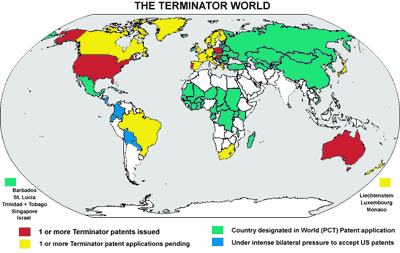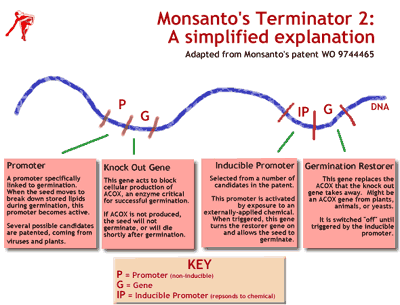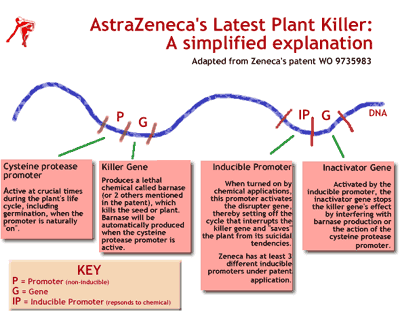Submitted by ETC Staff on
This is an appendix to RAFI's Communique on Traitor Technology, published in January 1999.

Monsanto's Terminator II is a technique for creating seeds that will not germinate unless exposed to a chemical. This is done by inserting a gene into a plant which inhibits germination by stopping seeds from producing ACOX, an enzyme that is critical for successful germination. Without ACOX, the seed will not germinate, or will the seedling will die shortly after germination. In the engineered seed, the germination inhibitor is expressed by default - it is always in the "on position", making the seed inviable.
The inhibitor gene is counteracted by turning on another gene whose effects override the inhibitor and restore the natural capacity of t
he seed to germinate. This gene, also inserted into the plant through genetic engineering, is linked to a chemically inducible promoter. Unlike the inhibitor, however, the restorer gene is set in the "off position" and will not function unless turned on by the chemical trigger, which is applied to foliage of a maturing plant or as a seed coating.
Of course application of the chemcial inducer does nothing to change the genotype of the plant, which remains genetically inhibited from germinating. The chemical inducer only permits germination of the single generation of seed to which it is applied. All subsequent generations of the variety would also require the chemical application in order to germinate.
The Terminator II patent draws on many different sets of lethal genes and promoters and claims a multiplicity of gene combinations for the termination system. The preferred embodiment prevents germination by manipulating one of a class of lipid breakdown genes found in many plants and animals (including rats and humans); but particularly from soya. Fertility is restored by

genes from the yeast Candida tropicalis spurred on by any of a number of different potential chemical promoters.
Seed of Terminator II plant varieties is infertile unless the chemical inducer is applied, making the varieties chemically-dependent for successful germination. If commercialized, Terminator II varieties would most likely be sold with the chemical inducer applied by the company or retailer as a seed coating, meaning that purchased seed would grow normally. Saved seed, however, would not germinate unless the farmer were to obtain and apply the inducer chemical. An alternative, hypothetical scenario, is that the chemical inducer could be co-branded with a pre-planting soil treatment, for instance, bundled with a soil inoculant, thus requiring farmers who wish to buy the Terminator seed to use the company's inoculant brand in order turn seed germination on.
Monsanto claims that the technology will prevent cross-pollination, preharvest sprouting, and in a bit of agricultural - Wall Street double entendre, seed "volunteers". Monsanto also claims that Terminator II is superior to Zeneca's Verminator because the fertility of Terminator II seeds can be restored with a single seed exposure to the chemical inducer, whereas Verminator varieties require the continuing presence of the chemical inducer in order to develop properly. Although Terminator II varieties may not be chemically-dependent during plant growth (at least for fertility) as Verminator varieties might be, for seed-saving farmers, the difference is minimal. Seed from both techniques are inviable. It is only a question of when the chemical is applied, not whether or not.
Monsanto says that the technique may be used with any plant; but especially with barley, canola, maize, cotton, oat, pisum, groundnut, rice, sorghum, soya, sugarcane, and wheat. Monsanto says it will apply for patents in 89 countries.

A Description of Zeneca's Verminator II
The technology described in Zeneca's new plant killer patent is to create plant varieties which must be exposed to chemicals in order to germinate and grow properly. Zeneca does this by inserting a gene into the plant which produces barnase, a compound which kills cells. This barnase gene is linked to a promoter called the cysteine protease promoter. The cystein protease promoter is active during germination and growth of the plant. This means that if the plant is left alone, the promoter will induce barnase production and the plant will kill itself during germination or shortly thereafter.
The plant's suicidal tendencies are overcome by another pair of genes which is also inserted into the plant by genetic engineering. This second combination consists of a disrupter gene linked to an inducible promoter. The disrupter gene, when activated, blocks the action of either the cysteine protease promoter or stops the barnase producing gene itself. The disrupter gene is turned on by the inducible promoter when the plant or seed is exposed to a chemical. The plant is thus chemically-dependent. It must be periodically exposed to Zeneca's chemicals in order to keep the disrupter gene active enough to prevent the plant from killing itself with barnase. Zeneca has at least three different inducible promoter systems under patent application.
The ameliorating effect of chemical exposure is only temporary. The dependency on chemical applications is inherited from generation to generation, so that saved seed is inviable and would also require chemicals in order to germinate and grow properly. Since the cysteine protease promoter is active not only at germination; but at other stages of growth, chemical dependency is not necessarily limited to germination. Zeneca's varieties may require additional chemical applications for plants to remain healthy as they mature.
Zeneca says that the technique may be used in all plants, especially canola, sunflower, tobacco, sugarbeet, cotton, wheat, barley, rice, maize, sorghum, tomatoes, mangoes, peaches, apples, pears, strawberries, bananas, melons carrot, lettuce, cabbage, and onion. Zeneca says it will seek patents in at least 77 countries.
A Description of the Novartis Family of Traitor Seed Patents
The Novartis patents are a large, broad set of related monopoly claims for the creation of chemically-dependent plants with proprietary inducible promoters and genes. The patents are particularly aimed at the external chemical regulation of a plant's innate resistance to pests and disease (11 natural resistance genes and proteins are patented), as well as introducing and turning on or off traits such as sterility, flowering, herbicide resistance, and nutritional and flavor qualities. Novartis believes it can apply the techniques to maize, wheat, soya, sunflower, rape, barley, sorghum, clover, tobacco, cotton, alfalfa, rice, potato, beet, phaseoulus, "vegetables", and probably other species.
The patented techniques do not exclusively pertain to triggering negative traits; but within the context of a series of very lengthy GE technique patents, Novartis explicitly claims the introduction of traitor traits by the deactivation of essential, natural resistance functions of plants. By linking this deactivation to indicible promoters, patented plants can be sold that will not exhibit natural positive traits like germination and pest resistance unless exposed to a chemical. Novartis blandly calls it "inactivation of endogenous regulation." According to the company, the technique results in plants in which "genes which are natively regulated can be regulated exclusively by the application to the plant of a chemical regulator." In other words, the plants are effectively drug addicted.
In one embodiment, a gene is introduced into a plant that interferes with the availablility of salicylic acid (a close relative of aspirin). Since salicylic acid plays a critic role in resistance to viruses and bacteria, when its availability is reduced, the plant's ability to resist disease is weakened.
The claims have been divided into multiple patents in most jurisdictions. Currently, members of the patent family have issued in Australia (2 patents), Poland, Portugal, and the USA (9). National or regional patent applications are pending in Australia (2), Canada, Denmark, EPO (3 patents, AT, BE, CH, DE, DK, ES, FR, GB, GR, IT, LI, LU, NL, SE), Finland, Hungary (2), Israel (2), Japan (2), Norway, New Zealand (2), and South Africa (2). Many additional countries (totaling 76) were designated by Novartis in its World (PCT) patent publication.
A Description of the University of Texas GRIM patent
The Texas GRIM patent is on a genetic insecticide. While the Texas inventors are trying to address the difficult problems caused by use of chemical pesticides through a potentially less toxic system, the traits patentred and controlled inthe system are powerful: it allows the creation of a genetically-engineered population of animals (including wild populations) whose altered genes will cause their cells to commit suicide if exposed to a particular chemical or environmental condition. The system's widespread use, it's potential application to higher animals, and - in the current corporate biotech product environment - the uses it could be put to if licensed to the private sector, are cause for concern.
A lethal gene called GRIM is introduced into an insect population together with an inducible promoter such that the insects die when exposed to a particular chemical or environmental condition. The GRIM gene is taken from a fly (Drosophila melanogaster) and kills cells by apoptosis, or programmed cell death. Apoptosis is a natual phenomenon; but normally is only expressed under specific circumstances and will not kill the entire organism. The patent mentions several possible inducible promoters, including ones related to heat shock and exposure to chemicals.
In practice, the idea is as follows: The GRIM gene and promoter are introduced into an insect population either by releasing transgenic insects and allowing them to breed with "wild" ones or, theoretically, by setting loose a transgenic virus ("recombinant vector") that infects the bugs and inserts the GRIM gene and promoter into their cells, particularly eggs, where the virus can quickly spread as the embryo grows. Either way, over time, the GRIM gene proliferates through the wild population affecting most, if not all, of the insects. At this point, insects in the population carrying the GRIM gene and promoter are likely to die if the promoter is turned on. The next step is to simply expose the insects to the appropriate activating chemical, or to wait for (or induce) the environmental condition that triggers it.
Although the patented GRIM gene comes from flies, its effects are the same when introduced into the cells of other insect species, as well as other animals, including mammals. This means the GRIM system might be used for controlling many different insect species. In mammals, Texas has tested the GRIM system in hampster and human cells, and it works. Texas says that the purpose of introdcucing the GRIM system into laboratory cell cultures of mammalian cells would be further study of the programmed cell death in humans and give scientists insight into how to stop it."
